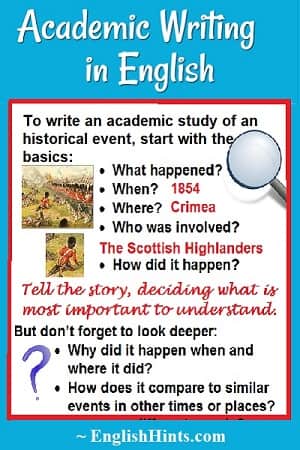Academic Writing in English-- Get it Right!
Academic writing in English has certain requirements, whether it is for a college essay or term paper, a research paper, or an article for a professional journal.
Writing academic English is quite formal, with certain expectations: clear organization, proper acknowledgment and citation of all the sources of facts, quotes, or ideas, and careful attention to the accuracy of all facts and conclusions.
Most academic writers avoid slang, contractions, and expression of personal preferences or feelings.
Correct grammar and spelling are important. Careless errors suggest a possible careless approach to facts as well. If scholars suspect inaccuracy or bias, they may decide the report is not worth consideration.
Good Academic Writing in English Follows these Steps:
1) Research.
a. Take careful notes. Be sure to include information about your sources for each fact or quote so you can correctly cite them when you write.
b. Read critically, thinking about the possible biases (implicit as well as explicit-- clearly stated) of your sources.
c. Check all your facts, trying to confirm them in at least two sources.
2) Look over and organize your data. Plan or outline the sequence of ideas and the best way to present them.
3) Write a first (“rough”) draft. Don’t worry about the perfect words at this stage. Just try to explain yourself clearly and show how the facts you have found lead to your conclusions. Make sure you provide convincing evidence and good examples for each point you make.
4) Write a second draft. Completely revise your first draft, checking for overall coherence, clarity, and smooth transitions that show the connections between ideas. Choose precise words to make your meaning clear. Cut unnecessary words (and paragraphs, if any), reorganize, and add explanations of anything that isn’t clear.
Polish your introduction (a brief statement of your main points). Make sure each main idea has supporting details and illustrations, and that they lead clearly to your conclusion.
Vary sentence structure for easier reading. A variety of sentences (some simple, some using various clauses to show the relationship between ideas) is less monotonous than sentence after sentence of the same length and form. A little variety can help your readers stay awake!
5) Add footnotes and (for a major paper or journal article) a bibliography, identifying the source of each fact or quotation and each idea that you got from someone else.
Accurate citations are essential, both to enable other scholars to check your data and decide if they can trust your conclusions, and to protect yourself from copyright violations and accusations of plagiarism.
(See this Purdue University explanation of plagiarism. It is considered stealing, and can harm or even destroy your academic career.)
6) Proofread and polish your writing. (It can help to read it aloud or have a friend read it. Look for errors or badly expressed ideas that you might have missed due to familiarity.)
Make sure you have included all the necessary facts and examples and shown clearly how they lead to your conclusions. Check for poor grammar, punctuation errors, or misspelled words.
Possible Sections of
a Term Paper,
Thesis, or Journal Article
- An abstract-- a brief summary of the most important facts and conclusions of a journal article, allowing readers to get the main ideas of the research and decide it they want to read more.
- Title page, giving the title, author(s), and date of publication or presentation.
- Introduction (sometimes called the Prologue) This can be a formal section or just the first paragraph(s) of the paper.
- Body of the paper, presenting main ideas and supporting details in an organized way (with sources cited in footnotes, either at the bottom of each page, the end of each chapter, or the end of the paper.
- Conclusion.
- Appendix (or sometimes two or even three appendices)-- optional, to provide supplementary facts or explanations possibly useful to the readers but not necessary to understand the paper’s main argument and conclusions.
- Bibliography-- an alphabetical listing of all the sources cited, and sometimes also of other useful sources for information on the topic.
- (Also possible, usually only for books)-- an Index-- an alphabetical listing of each important word and the pages on which it can be found. (This works like the Ctrl-F ‘Find’ function on computers.)
Most papers will only have a few of these sections, possibly only a title page and the paper itself, with introduction , citations, and conclusion included without separate headings or pages.
If you would like more information on academic writing, including how to avoid common grammatical errors and how to proofread, see Purdue University’s writing resources. (EnglishHints has a checklist for editing and proofreading. You can also practice them here.
Home > Learn to Write English > Academic Writing.
Didn't find what you
needed? Explain what you want in the search box below.
(For example, cognates, past tense practice, or 'get along with.') Click to see the related pages on EnglishHints.
| site search by freefind | advanced |






